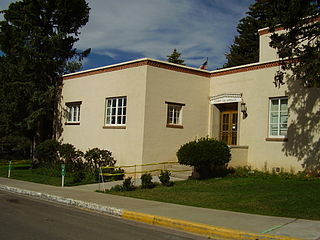
The New Hampshire Supreme Court is the supreme court of the U. S. state of New Hampshire and sole appellate court of the state. The Supreme Court is seated in the state capital, Concord. The Court is composed of a Chief Justice and four Associate Justices appointed by the Governor and Executive Council to serve during "good behavior" until retirement or the age of seventy. The senior member of the Court is able to specially assign lower-court judges, as well as retired justices, to fill vacancies on the Court.

The Supreme Court of Maryland is the highest court of the U.S. state of Maryland. Its name was changed on December 14, 2022 from the Maryland Court of Appeals to its current name by a constitutional amendment. The court, which is composed of one chief justice and six associate justices, meets in the Robert C. Murphy Courts of Appeal Building in the state capital, Annapolis. The term of the Court begins the second Monday of September. The Court is unique among American courts in that the justices wear red robes.

The government of Maryland is conducted according to the Maryland Constitution. The United States is a federation; consequently, the government of Maryland, like the other 49 state governments, has exclusive authority over matters that lie entirely within the state's borders, except as limited by the Constitution of the United States.

The United States Court of Appeals for the Federal Circuit is a United States court of appeals that has special appellate jurisdiction over certain types of specialized cases in the U.S. federal court system. It has exclusive appellate jurisdiction over all U.S. federal cases involving patents, trademarks, government contracts, veterans' benefits, public safety officers' benefits, federal employees' benefits, and various other categories. Unlike other federal courts, the Federal Circuit has no jurisdiction over cases involving criminal, bankruptcy, immigration, or U.S. state law.

The New York Court of Appeals is the highest court in the Unified Court System of the State of New York. The Court of Appeals consists of seven judges: the Chief Judge and six Associate Judges who are appointed by the Governor and confirmed by the State Senate to 14-year terms. The Chief Judge of the Court of Appeals also heads administration of the state's court system, and thus is also known as the Chief Judge of the State of New York. Its 1842 Neoclassical courthouse is located in New York's capital, Albany.

The Supreme Court of Florida is the highest court in the U.S. state of Florida. It consists of seven members: the chief justice and six justices. Six members are chosen from six districts around the state to foster geographic diversity, and one is selected at large.

The Supreme Court of Virginia is the highest court in the Commonwealth of Virginia. It primarily hears direct appeals in civil cases from the trial-level city and county circuit courts, as well as the criminal law, family law and administrative law cases that are initially appealed to the Court of Appeals of Virginia. It is one of the oldest continuously active judicial bodies in the United States. It was known as the Supreme Court of Appeals until 1970, when it was renamed the Supreme Court of Virginia because it has original as well as appellate jurisdiction.
The Alaska Supreme Court is the state supreme court for the U.S. state of Alaska. Its decisions are binding on all other Alaska state courts, and the only court its decisions may be appealed to is the Supreme Court of the United States. The Alaska Supreme Court hears appeals from lower state courts and also administers the state's judicial system.

The Supreme Court of Missouri is the highest court in the state of Missouri. It was established in 1820 and is located at 207 West High Street in Jefferson City, Missouri. Missouri voters have approved changes in the state's constitution to give the Supreme Court exclusive jurisdiction – the sole legal power to hear – over five types of cases on appeal. Pursuant to Article V, Section 3 of the Missouri Constitution, these cases involve:
The Court of Appeals of Virginia, established January 1, 1985, is an intermediate appellate court of 17 judges that hears appeals from decisions of Virginia's circuit courts and the Virginia Workers' Compensation Commission. The Court sits in panels of at least three judges, and sometimes hears cases en banc. Appeals from the Court of Appeals go to the Supreme Court of Virginia.

The Kentucky Supreme Court was created by a 1975 constitutional amendment and is the state supreme court of the U.S. state of Kentucky. Prior to that the Kentucky Court of Appeals was the only appellate court in Kentucky. The Kentucky Court of Appeals is now Kentucky's intermediate appellate court.

The California Courts of Appeal are the state intermediate appellate courts in the U.S. state of California. The state is geographically divided along county lines into six appellate districts. The Courts of Appeal form the largest state-level intermediate appellate court system in the United States, with 106 justices.

The Supreme Court of Georgia is the highest judicial authority of the U.S. state of Georgia. The court was established in 1845 as a three-member panel. Since 1896, the justices have been elected by the people of the state. The justices are currently elected in statewide non-partisan elections for six-year terms, with any vacancies filled through an appointment by the Governor.

The New Mexico Supreme Court is the highest court in the U.S. state of New Mexico. It is established and its powers defined by Article VI of the New Mexico Constitution. It is primarily an appellate court which reviews civil and criminal decisions of New Mexico's trial courts of general jurisdiction and certain specialized legislative courts, only having original jurisdiction in a limited number of actions. It currently resides in the New Mexico Supreme Court Building in Santa Fe.

The Washington Court of Appeals is the intermediate level appellate court for the state of Washington. The court is divided into three divisions. Division I is based in Seattle, Division II is based in Tacoma, and Division III is based in Spokane.
The Georgia Court of Appeals is the intermediate-level appellate court for the U.S. state of Georgia.

The New Mexico Court of Appeals is the intermediate-level appellate court for the state of New Mexico.
The Government of Guam (GovGuam) is a presidential representative democratic system, whereby the President is the head of state and the Governor is head of government, and of a multi-party system. Guam is an organized, unincorporated territory of the United States with policy relations between Guam and the US under the jurisdiction of the Office of Insular Affairs.
The Kansas Court of Appeals is the intermediate-level appellate court for the U.S. state of Kansas.
The Judiciary of Virginia is defined under the Constitution and law of Virginia and is composed of the Supreme Court of Virginia and subordinate courts, including the Court of Appeals, the Circuit Courts, and the General District Courts. Its administration is headed by the Chief Justice of the Supreme Court, the Judicial Council, the Committee on District Courts, the Judicial Conferences, the Judicial Inquiry and Review Commission, and various other offices and officers.














